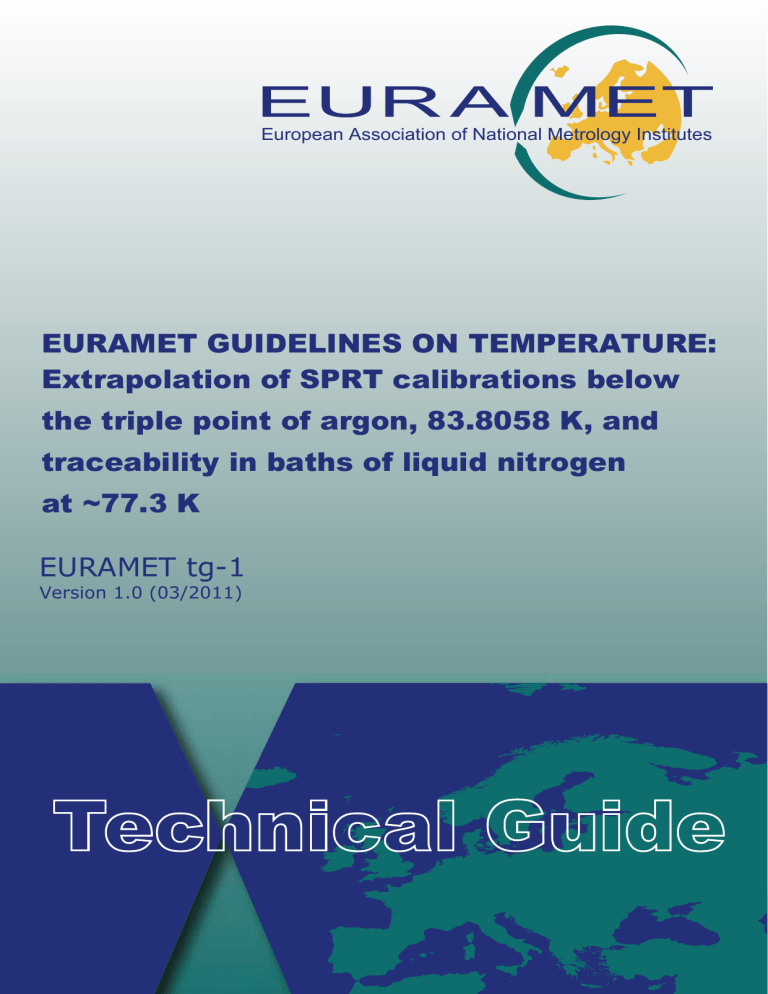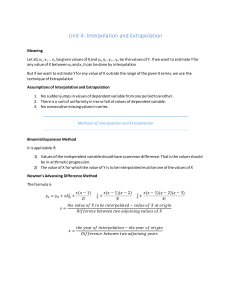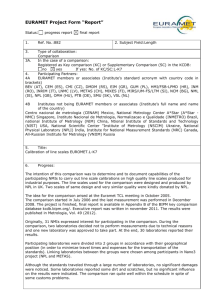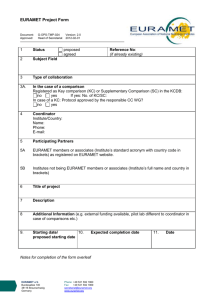
European Association of National Metrology Institutes EURAMET GUIDELINES ON TEMPERATURE: Extrapolation of SPRT calibrations below the triple point of argon, 83.8058 K, and traceability in baths of liquid nitrogen at ~77.3 K EURAMET tg-1 Version 1.0 (03/2011) Technical Guide EURAMET tg-1 Version 1.0 (03/2011) EURAMET GUIDELINES ON TEMPERATURE: Extrapolation of SPRT calibrations below the triple point of argon, 83.8058 K, and traceability in baths of liquid nitrogen at ~77.3 K Purpose This document has been produced to enhance the equivalence and mutual recognition of calibration results obtained by laboratories. Authorship and Imprint This document was developed by the EURAMET e.V., Technical Committee for Thermometry. 1st edition March 2011 EURAMET e.V. Bundesallee 100 D-38116 Braunschweig Germany e-mail: secretariat@euramet.org phone: +49 531 592 1960 Official language The English language version of this document is the definitive version. The EURAMET Secretariat can give permission to translate this text into other languages, subject to certain conditions available on application. In case of any inconsistency between the terms of the translation and the terms of this document, this document shall prevail. Copyright The copyright of this document (EURAMET tg-1, version 1.0 – English version) is held by © EURAMET e.V. 2010. The text may not be copied for sale and may not be reproduced other than in full. Extracts may be taken only with the permission of the EURAMET Secretariat. ISBN 978-3-942992-00-8 Guidance Publications This document gives guidance on measurement practices in the specified fields of measurements. By applying the recommendations presented in this document laboratories can produce calibration results that can be recognized and accepted throughout Europe. The approaches taken are not mandatory and are for the guidance of calibration laboratories. The document has been produced as a means of promoting a consistent approach to good measurement practice leading to and supporting laboratory accreditation. The guide may be used by third parties e.g. National Accreditation Bodies, peer reviewers witnesses to measurements etc., as a reference only. Should the guide be adopted as part of a requirement of any such party, this shall be for that application only and EURAMET secretariat should be informed of any such adoption. On request EURAMET may involve third parties in a stakeholder consultations when a review of the guide is planned. Please register for this purpose at the EURAMET Secretariat. No representation is made nor warranty given that this document or the information contained in it will be suitable for any particular purpose. In no event shall EURAMET, the authors or anyone else involved in the creation of the document be liable for any damages whatsoever arising out of the use of the information contained herein. The parties using the guide shall indemnify EURAMET accordingly. Further information For further information about this document, please contact your national contact person of the EURAMET Technical Committee for Thermometry (see www.euramet.org). Technical Guide EURAMET tg-1 Version 1.0 (03/2011) Extrapolation of SPRT calibrations below the Triple point of argon, 83.8058 K, and traceability in baths of liquid nitrogen at ~77.3 K Contents 1 Introduction....................................................................................................................... 1 2 Experimental basis for the extrapolation ............................................................................. 2 3 Conclusions and recommendations ...................................................................................... 4 4 References ........................................................................................................................ 5 Technical Guide EURAMET tg-1 Version 1.0 (03/2011) Extrapolation of SPRT calibrations below the triple point of argon, 83.8058 K, and traceability in baths of liquid nitrogen at ~77.3 K Abstract The International Temperature Scale of 1990, ITS-90, provides the basis for traceable temperature calibrations using Standard Platinum Resistance Thermometers (SPRTs) over the temperature range from the triple point of hydrogen, 13.8033 K to the freezing point of silver, 1234.93 K. Unfortunately, it is not practical to calibrate SPRTs of the long-stem design in sub-ranges of the ITS-90 which extend below the triple point of argon, 83.8058 K. Nevertheless, long-stem SPRTs are widely used as standards for calibrations carried out in baths of liquid nitrogen at approximately 77.3 K, for which a limited extrapolation of the SPRT calibration range is required. Drawing on the results and experience from five National Measurement Institutes in Europe, the USA and Japan, these guidelines recommend that the standard uncertainty associated with the extrapolation of the calibration of SPRTs in the sub-range of the ITS-90 from the triple point of water to the triple point of argon, down to 77.3 K, is adopted as 0.15 mK (k = 1). 1 Introduction Standard Platinum Resistance Thermometers, SPRTs, of the long-stem design are often calibrated in the range of temperature from the triple point of water, 273.16 K, to the triple point of argon, TP Ar, 83.8058 K. In the International Temperature Scale of 1990, ITS-90, this can be done using measurements at the triple points of water, mercury (234.3156 K) and argon, and applying a two-term equation for the deviations from the specified SPRT reference function. Such thermometers are capable of being used to somewhat lower temperatures, and in particular they are conveniently used as standards for the calibration of PRTs and other thermometers in baths of liquid nitrogen. This is a relatively simple and efficient technique in which several thermometers can be calibrated in a few hours. Unfortunately, at ~ 77.3 K, the temperature of the bath is ~ 6.5 K below the range of the SPRT calibration, and the questions arise as to what is the traceability of this procedure, and what are the uncertainties associated with the extrapolation of the SPRT calibration range. These questions are not discussed in either the Supplementary Information for the ITS-90 [1] or the CCTWG3 document Uncertainties in the realisation of the SPRT subranges of the ITS-90 [2], because the extrapolation is not a specific provision of the ITS-90. Nevertheless, a number of NMIs, such as NIST in the USA and NPL in the UK, have for many years made use of the extrapolation, with an additional component of uncertainty to allow for it. More recently the topic has been raised by laboratories which would like to make the extrapolation but do not have the means to validate it. This document gives general guidance to NMIs and accreditation bodies on the associated uncertainty. It is based on Document CCT/10-20 [3], but the support for the extrapolation was also provided in three other documents submitted to the 2010 meeting of the CCT [4-6]. EURAMET tg-1, Version 1.0 (03/2011) Page 1 2 Experimental basis for the extrapolation Several laboratories have investigated the effectiveness of the extrapolation and the uncertainties resulting from it, and following is a summary of the evidence from five sources. 2.1 NIST, USA Section 7.5 of NIST Special Publication 250-81 [7] discusses extrapolation and states: ‘The NIST Thermometry Group does not advocate extrapolating any calibrated SPRT beyond the temperature range of calibration. However, in practice some of the ITS-90 temperature subranges may be extrapolated over a small range with an additional uncertainty of less than 1 mK [8]’. Table 17 of [7] states that the uncertainty which NIST associates with the extrapolation of the range to – 200 °C is 0.1 mK (k = 2). Figure 21 of [8] shows the error introduced for a particular NIST helium-filled capsule-type SPRT (cSPRT) by extrapolating the calibration below the argon triple point, and Section 2.3.5 states that ‘extrapolating downward to about the boiling point of nitrogen (77 K) results in a fairly insignificant error in this case [~0.025 mK] and, thus, can be done with the usual caution that some thermometers may not be as good as that of Figure 21’. 2.2 NPL, UK At NPL the extrapolation was similarly investigated using helium-filled cSPRTs which had been calibrated throughout the cryogenic range. Calibrations down to the argon point were compared with sub-ranges to lower temperatures (the triple points of O2, Ne and H2), using data for 14 cSPRTs from manufacturers, in the UK, USA and Russia, now supplemented by data from 3 recently made thermometers. The results presented below specifically compare the calibrations in the sub-range to the TP O2, 54.3584 K, with that to the TP Ar extrapolated to 54.3584 K. Comparisons with the other low-temperature sub-ranges produced the same results within 0.13 mK, and all but one were within 0.05 mK at 77.3 K. Figure 1 from [3] shows, as expected, that the differences between the sub-ranges are zero at the fixed points and that there is some dispersion in between. This is the sub-range inconsistency, but being experimentally determined it also includes the effects of errors or inconsistencies in the realisation and calibration, which affect the two sub-ranges differently. For orientation, the inner bold lines in the figure show the effect of errors of ± 2.10-6 (equivalent to about 0.5 mK) in the resistance ratio at the argon point, W(Ar), and the bold dotted lines show the same for W(Hg). Such errors, especially at the mercury point, would be large enough to account for all of the apparent sub-range inconsistency. The sensitivities to errors in each sub-range are well known and have been published in Figures 1.7d and 1.7e of [1] and Figures D8 and D9 of [2]. In the extrapolation below TP Ar, more seen clearly in Figure 2, the differences diverge, but all but one are between - 1.9 mK and + 1.7 mK at the TP O2. The exception is a thermometer which only just meets the ITS-90 criteria for acceptance, and it deviates by -2.4 mK at TP O2. For this sample of 17 cSPRTs the mean difference at TP O2 is (– 0.3 ± 1.2) mK (standard deviation). The maximum difference at 77.3 K is –0.26 mK and the mean is (– 0.04 ± 0.12) mK. These calculations were supplemented by comparisons between long-stem and capsule-type SPRTs in liquid nitrogen (although such comparisons have significantly larger uncertainties), and together they have supported the use at NPL of long-stem SPRTs in the nitrogen bath for routine UKAS-accredited calibrations with an uncertainty of 1.7 mK (k = 2). EURAMET tg-1, Version 1.0 (03/2011) Page 2 (T(Ar-TPW) - T(O2-TPW)) / mK 3 2 1 0 -1 -2 -3 50 100 150 200 250 T90 / K Figure 1. Differences between the ITS-90 sub-ranges to the triple-points of argon and oxygen for 17 capsule-type SPRTs [3]. The bold dotted and full lines indicate the effect of errors or inconsistencies of ± 2.10-6 in W(Hg) and W(Ar), respectively. (T(Ar-TPW) - T(O2-TPW)) / mK 3 2 1 0 -1 -2 -3 50 60 70 80 90 100 T90 / K Figure 2. As for Figure 1, highlighting the region below TP Ar EURAMET tg-1, Version 1.0 (03/2011) Page 3 2.3 LNE, France LNE has built an apparatus for the calibration of long-stem SPRTs in liquid nitrogen with uncertainties in the region of 2 mK, using capsule-type SPRTs which have been calibrated at least down to the oxygen triplepoint [4]. The differences (TSPRT – TcSPRT) for 8 SPRTs from four sources were in the range 0 to 2.3 mK. The accuracy of the extrapolation of the cSPRT calibrations below the TP Ar was also checked, as at NIST and NPL: the mean difference for 7 cSPRTs from four sources was 0.25 mK with an uncertainty of 0.3 mK. It was concluded that the bias and uncertainty coming from the extrapolation was not the main component of uncertainty, and that for routine calibration it is possible to use the extrapolated value of SPRTs with an uncertainty which mainly takes into account the uncertainty at the water, mercury and argon points propagated down to 77 K. 2.4 NMIJ, Japan The NMIJ document [5] shows the differences between the calibrations in the sub-ranges to the TP Ar and TP O2 for five cSPRTs, and it also considers a further seven cSPRTs from the CCT Key Comparison, CCT-K2 [9]. For these thermometers the standard uncertainty at 77.3 K due to the extrapolation is estimated to be 0.17 mK. The uncertainties of the calibration of long stem SPRTs at the water, mercury and argon triple points, propagated down to 77.3 K, is five times larger than this, and the uncertainties of comparisons in a liquid nitrogen bath is ten or more times larger. These comparisons showed differences between about –1.0 mK to + 1.5 mK, for 9 SPRTs, a similar range of values to those at LNE. On the basis of their findings, NMIJ has recommended that calibration laboratories in Japan add an uncertainty component of 0.17 mK (k =1) to their uncertainty budgets for comparison calibrations in liquid nitrogen, to allow for the SPRT extrapolation. 2.5 INRiM, Italy Finally, at INRiM data for a total of 22 cSPRTs with calibrations from IMGC (now INRiM), and also from NPL and NRC, have been investigated [6]. The differences at 77.3 K between the subrange to TP O2 and the extrapolated sub-range to TP Ar were found to lie in the range from –0.43 mK and + 0.22 mK. These results are consistent with the findings at NPL, NMIJ and the other laboratories. 3 Conclusions and recommendations For the purposes of providing guidance it is necessary to consider whether the results and procedures of NIST and NPL and elsewhere can be generalised to other SPRTs and adopted by NMIs where only limited internal checks are possible and, if so, what uncertainty should be recommended for the extrapolation. Given that SPRT characteristics are highly reproducible from one to the next, it seems unlikely that a markedly different behaviour would be found in any SPRT (long-stem or capsule-type) which meets the ITS90 criteria, though there is no absolute proof of this. The uncertainty of an extrapolation to TP O2, if it is based on the upper limit as found at NPL (2.4 mK), may be significant with respect to other uncertainties in the use of an SPRT. On the other hand, at 77.3 K the dispersion is still relatively small (about half the dispersion in the interval between TP Ar and TP Hg), and it is therefore reasonable to accept the extrapolation and to generalise the result to all SPRTs. If the NPL sample of SPRTs is taken as representative, with an additional component of uncertainty at 77.3 K of 0.26 mK (upper limit), the standard uncertainty is 0.26/√3 = 0.15 mK. This additional uncertainty is of similar magnitude to the maximum uncertainty due to Type 1 nonuniqueness (sub-range inconsistency) in the argon-to water sub-range found by Meyer and Tew [10] (see also Section 7.1 of [2]). It encompasses all the results for the NPL sample of 17 cSPRTs without making any allowance for the fact that much of the dispersion is likely to be experimental in origin. EURAMET tg-1, Version 1.0 (03/2011) Page 4 It is therefore recommended that 0.15 mK is adopted as the standard uncertainty in extrapolating the calibration of SPRTs in the subrange of the ITS-90 from the triple point of water to the triple point of argon, down to 77.3 K. It should be clear that this recommendation only applies to extrapolations of SPRTs which meet the requirements of the ITS-90, and that extrapolations of the calibrations of other PRTs must be checked by comparison with SPRTs. Moreover, the uncertainty of the extrapolation is in addition to the components relating to the propagation of the uncertainties in the SPRT calibration at the triple points of argon and mercury. It is further recommended that, as for other comparison calibrations, at least two SPRTs should be used as standards, this being particularly important for comparisons in liquid nitrogen to ensure that their calibrations are mutually consistent. 4 1. 2. 3. 4. 5. 6. 7. 8. 9. References Supplementary Information for the International Temperature Scale of 1990, BIPM, Sèvres, 1990, http://www.bipm.org/en/publications/its-90_supplementary.html D. R. White, M. Ballico, V. Chimenti, S. Duris, E. Filipe, A. Ivanova, A. Kartal Dogan, E. Mendez-Lango, C. Meyer, F. Pavese, A. Peruzzi, E. Renaot, S. Rudtsch, K. Yamazawa, Uncertainties in the Realisation of the SPRT Subranges of the ITS-90, Document CCT/08-19/rev, BIPM, Sèvres, 2008, http://www.bipm.org/cc/CCT/Allowed/24/D19_rev_WG3_Doc_rev_10July2009.pdf R. Rusby, Uncertainties in the extrapolation of SPRT calibrations in the ITS-90 below the triple point of argon, 83.8058 K, Document CCT/10-20, BIPM, Sèvres, 2010. Y. Hermier, I Didialaoui and D. Jouin, About the extrapolation at 77 K for SPRTs calibrated in the 83 K – 273 K temperature range, Document CCT/10-10, BIPM, Sèvres, 2010. T. Nakano and O. Tamura, CCT/10-21. Extrapolation of the ITS-90 down to the boiling point of nitrogen from the triple point of argon, Document CCT/10-21, BIPM, Sèvres, 2010. P.P.M. Steur, Further supporting material regarding extrapolation from the Ar TP to 77 K, CCT/10-32, BIPM, Sèvres, 2010. G. F. Strouse, NIST Special Publication 250-81 (2008): Standard Platinum Resistance Thermometer Calibrations from the Ar TP to the Ag FP. B. W. Mangum, and G. T. Furukawa, NIST Technical Note 1265 (1990), Guidelines for Realizing the International Temperature Scale of 1990 (ITS-90). A. Steele et al, Metrologia 9 (2002) 551-571. C. W. Meyer and W. L. Tew, ITS-90 non-uniqueness from PRT subrange inconsistencies over the range 24.56 K to 273.16 K, Metrologia 43 (2006) 341-352 . EURAMET tg-1, Version 1.0 (03/2011) Page 5





